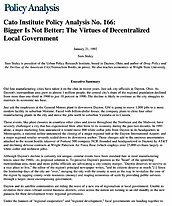Just ask the employees at the General Motors plant in downtown Dayton. GM is going to move 1,000 jobs to a more modern facility in suburban Moraine. Faced with billion-dollar losses, the company plans to close four other manufacturing plants in the city and move the jobs north to suburban Vandalia or to Canada.
Those events, like plant closures in countless other cities and towns throughout the Northeast and the Midwest, have severely challenged a city that has experienced blow after blow to its economy during the past two decades. In 1991 alone, a major marketing firm announced it would move 800 white-collar jobs from Dayton to its headquarters in Minneapolis; a national airline announced the closing of a major regional hub at the Dayton International Airport; and a major regional retailer severely scaled down its downtown anchor. Those changes add to the ominous uncertainties attached to the recent hostile takeover of Fortune 500 company NCR (founded and headquartered in Dayton) by AT&T and declining defense contracts at Wright Patterson Air Force Base (which employs over 25,000 civilians largely in white-collar and technical jobs).
Although Dayton’s decline is certainly not unique–similar events have been standard fare in most manufacturing towns since the 1960s–its proposed solution is. To preserve Dayton’s position as the “heart” of the sprawling metropolitan area, more and more public officials are advocating a city-county merger. “Dayton deserves to survive as a nice place to live,” the editor of the region’s principal newspaper writes, “and its citizens deserve as much.”[1] Since the leadership days of the city are “over,” merging the city with the county is seen as the way to revitalize the core of the region by tapping county-wide resources (money) and reaping economies of scale by providing public services through a larger, more encompassing government.
Dayton and its satellite communities are riding the wave of a new era of regionalism in local government. Unable to revitalize their once-vibrant central business districts, cities across the nation are turning to an old standby as the new panacea for their development woes: regional governance.
Under the banners of “regional cooperation” and “regional development,” local governments are banding together to “plan” the future of their metropolitan areas. Fragmentation and decentralization, regionalists argue, are compromising the ability of cities to compete successfully in an increasingly competitive global environment. Only by pulling together through cooperative arrangements and, in some cases, consolidating local governments can metropolitan areas solve pressing urban problems such as poverty, affordable housing, education, and job creation.
The new proposals move far beyond the more limited special districts designed to provide a specific public service, such as parks and recreation, over a wide geographic area. The regional governance proposals that form the core of the new wave of regionalism are comprehensive. Most involve consolidating economic development functions under a unified government whose authority supersedes that of independent municipalities and the private sector. Proponents of consolidation argue that providing public services and coordinating programs through a government monopoly will be more efficient than allowing dozens, sometimes hundreds, of smaller governments to compete against each other.
The trend toward regional government, however, is likely to exacerbate the problems it is intended to solve. Although there are legitimate concerns about cooperation among local governments, particularly on large public projects such as road and sewer systems, a more consolidated local government structure would probably decrease the ability of local governments to provide public goods efficiently and cost-effectively. Attempts to consolidate governmental authority imply that public goods and services are best handled by a single comprehensive organization. Experiences with regional attempts to solve local problems have confirmed the worst fears of opponents of regional government about the excesses of monopoly government. Moreover, the private sector, with its more innovative and flexible alternatives, has often been more efficient than larger, bureaucratically controlled local governments.
The solution is more likely to be found in a competitive, decentralized governmental system. Instead of undermining the diverse interests that make up metropolitan America, urban policy should free political markets to ensure that the desires of local residents are fully expressed in the policymaking process and the private sector is given the fullest possible latitude to provide needed goods and services. Public services are often provided more effectively and efficiently through privatization, which allows private markets to develop innovative new services and products that reflect the changing needs and wants of local consumers. That goal can be reached only by avoiding a consolidated, monopoly regional government system that depends on one organization to provide all public goods. A decentralized, fragmented political system that is competitive and responsive can achieve that goal.


